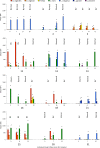Multiplex detection of bacteria associated with normal microbiota and with bacterial vaginosis in vaginal swabs by use of oligonucleotide-coupled fluorescent microspheres
- PMID: 19794034
- PMCID: PMC2786665
- DOI: 10.1128/JCM.00112-09
Multiplex detection of bacteria associated with normal microbiota and with bacterial vaginosis in vaginal swabs by use of oligonucleotide-coupled fluorescent microspheres
Abstract
Bacterial vaginosis (BV) is a recurrent condition that is associated with a range of negative outcomes, including the acquisition of human immunodeficiency virus and other sexually transmitted diseases, preterm births, and pelvic inflammatory disease. In contrast to the Lactobacillus-dominated normal vaginal microbiota, BV is characterized by a lack of lactobacilli and an abundance of anaerobic and gram-negative organisms, including Gardnerella vaginalis and Atopobium vaginae. To date, the laboratory diagnosis of BV has relied upon the fulfillment of criteria determined by microscopic observation of Gram-stained vaginal swabs. We describe a molecular-based method for the easy determination of the species profile within the vaginal microbiota based on the amplification of the chaperonin-60 genes of all bacteria present in the swab and hybridization of the amplicon to species-specific oligonucleotide-coupled fluorescent beads that are identified by flow cytometry with a Luminex instrument. We designed a nineplex Luminex array for characterization of the vaginal microbiota and applied it to the analysis of vaginal swabs from individuals from Africa and North America. Using the presence of A. vaginae or G. vaginalis, or both, as the defining criterion for BV, we found that the method was highly specific and sensitive for the diagnosis of BV using microscopy as a gold standard.
Figures





References
-
- Atassi, F., D. Brassart, P. Grob, F. Graf, and A. L. Servin. 2006. Lactobacillus strains isolated from the vaginal microbiota of healthy women inhibit Prevotella bivia and Gardnerella vaginalis in coculture and cell culture. FEMS Immunol. Med. Microbiol. 48:424-432. - PubMed
-
- Banoo, S., D. Bell, P. Bossuyt, A. Herring, D. Mabey, F. Poole, P. G. Smith, N. Sriram, C. Wongsrichanalai, R. Linke, R. O'Brien, M. Perkins, J. Cunningham, P. Matsoso, C. M. Nathanson, P. Olliaro, R. W. Peeling, and A. Ramsay. 2006. Evaluation of diagnostic tests for infectious diseases: general principles. Nat. Rev. Microbiol. 4:S21-S31. - PubMed
-
- Bradshaw, C. S., S. N. Tabrizi, C. K. Fairley, A. N. Morton, E. Rudland, and S. M. Garland. 2006. The association of Atopobium vaginae and Gardnerella vaginalis with bacterial vaginosis and recurrence after oral metronidazole therapy. J. Infect. Dis. 194:828-836. - PubMed
-
- Brotman, R. M., and J. Ravel. 2008. Ready or not: the molecular diagnosis of bacterial vaginosis. Clin. Infect. Dis. 47:44-46. - PubMed
Publication types
MeSH terms
Substances
LinkOut - more resources
Full Text Sources
Other Literature Sources
Research Materials

